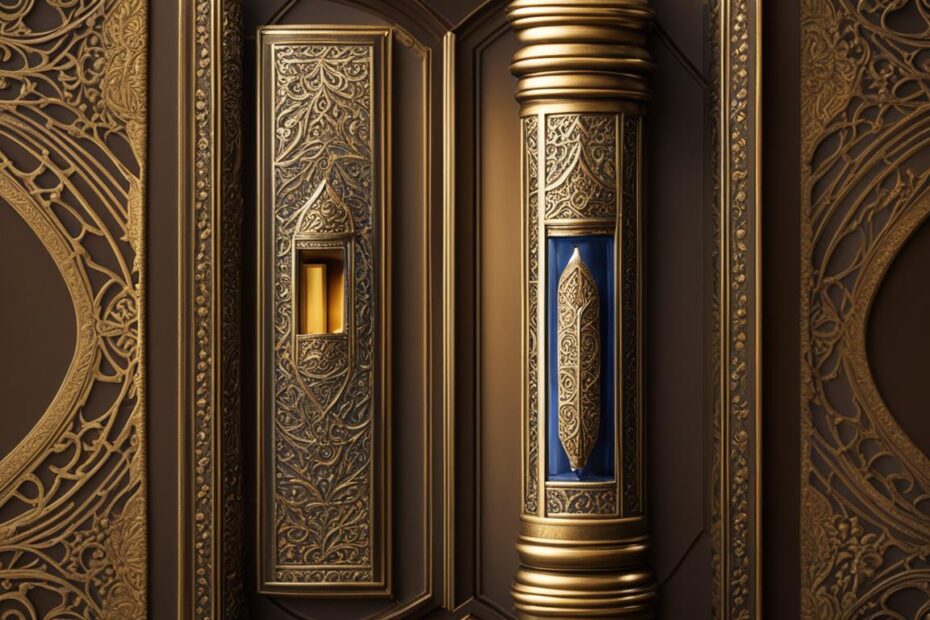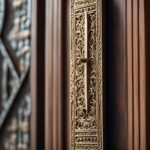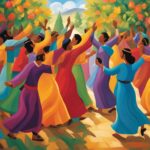The mezuzah is a small container attached to the doorposts of Jewish homes, containing a parchment scroll with handwritten prayers. These prayers are known as the Shema, which is a declaration of faith in one God. The scroll includes the first two verses of the Shema prayer, which begins with “Hear, O Israel, the Lord is our God, the Lord is One.” The prayer is written in Hebrew by a scribe and is considered a sacred reminder of the Jewish connection to God and His Kingdom.
Key Takeaways:
- The mezuzah contains the Shema prayer, a declaration of faith in one God.
- The prayer is written in Hebrew by a scribe and is considered sacred.
- The mezuzah serves as a reminder of the Jewish connection to God and His Kingdom.
- It is attached to the doorposts of Jewish homes for spiritual protection and blessing.
- The mezuzah symbolizes the Jewish faith and the commandments of God.
The Importance of the Mezuzah Scroll
The mezuzah scroll is the central component of the mezuzah. It contains the handwritten prayers of the Shema, which serve as a reminder of the Jewish faith and the commandment to love and serve God with all one’s heart, soul, and strength. The prayers are written on a parchment scroll using a specific Hebrew script and must be written by a trained scribe. Every letter and word must be meticulously formed and arranged, as even the smallest mistake can invalidate the entire scroll. The mezuzah scroll is a symbol of God’s presence in the Jewish home and a source of spiritual protection and blessing.
The mezuzah scroll holds deep significance in Jewish tradition. It represents the connection between the Jewish people and God, serving as a constant reminder of their faith and commitment to His commandments. The act of affixing the mezuzah scroll to the doorpost is seen as a sacred duty, symbolizing the dedication to a God-centered life. The presence of the mezuzah scroll in the home is believed to bring divine protection and blessings to the inhabitants, creating a sacred space where the spiritual and physical realms intertwine.
The mezuzah scroll is a tangible representation of the Jewish people’s covenant with God. It is a physical reminder of our connection to the divine and our commitment to live according to His teachings. By displaying the mezuzah scroll, we declare our faith and invite God’s presence into our lives.
The mezuzah scroll is not merely a decorative item but a powerful symbol of Jewish identity and spirituality. It serves as a testament to the rich traditions and beliefs that have been passed down through generations. By preserving the sacred prayers within the mezuzah scroll, Jews honor their heritage and ensure that their faith continues to thrive in the present and future.
The Meaning behind the Mezuzah Case
The mezuzah case is not just a decorative container; it holds deep symbolic meaning in Jewish tradition. Made from a variety of materials such as wood, metal, or ceramic, the mezuzah case serves both a practical and spiritual purpose.
On a practical level, the case protects the delicate parchment scroll, ensuring that the sacred prayers within are preserved and remain intact. It shields the scroll from damage caused by the elements or accidental contact.
Symbolically, the mezuzah case represents the visible representation of the mezuzah on the doorpost. It serves as a constant reminder of God’s presence and the connection to the Jewish faith. The design of the case can reflect personal or cultural preferences, allowing individuals to express their unique identity while still adhering to the timeless tradition of the mezuzah.
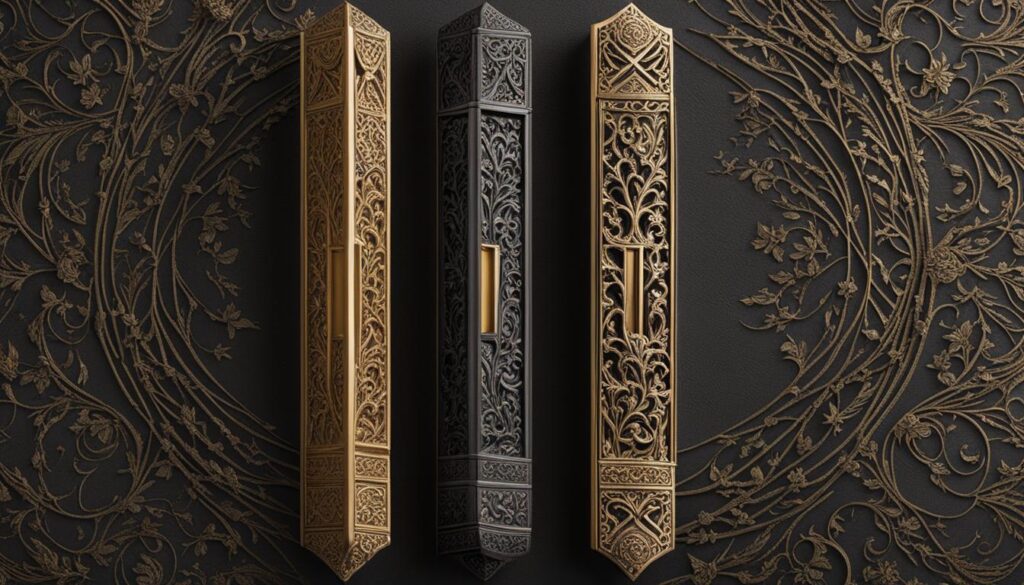
Purpose of the Mezuzah Case
“The mezuzah case is not just a decorative container; it holds deep symbolic meaning in Jewish tradition.”
The mezuzah case also serves as a visual representation of the mezuzah’s significance within the home. It acts as a beacon, reminding individuals of their connection to God and their commitment to living a God-centered life. By affixing the mezuzah case to the doorpost, believers create a physical and spiritual boundary, inviting God’s blessings and protection into their homes.
Various Designs and Spectrums
The mezuzah case comes in a variety of designs, catering to different tastes and preferences. From intricate carvings to minimalist styles, there is a mezuzah case to suit every individual’s aesthetic sensibilities. Some cases feature symbols or motifs that reflect specific traditions or cultural backgrounds, further enriching the mezuzah’s symbolism in the context of the wearer’s heritage.
The Mezuzah Case and its Significance
“The mezuzah case serves as a constant reminder of God’s presence and the connection to the Jewish faith.”
The mezuzah case plays a vital role in preserving the sacred prayers within, protecting them from physical harm, and visually representing the mezuzah in the Jewish home. It embodies the enduring connection to God and His commandments, as well as the individual’s dedication to a God-centered life. The mezuzah case is not just a container; it is a tangible expression of faith and a source of spiritual grounding for believers.
| Mezuzah Case | Material | Design |
|---|---|---|
| Wooden Mezuzah Case | Wood | Carvings, engravings |
| Metal Mezuzah Case | Metal | Ornate patterns |
| Ceramic Mezuzah Case | Ceramic | Hand-painted designs |
Where to Hang a Mezuzah Scroll
The placement of the mezuzah scroll plays a significant role in the observance and practice of Jewish traditions. The mezuzah should be hung on the right side of the doorpost, in a slanting position, with the top facing inward. This positioning is important as it aligns with the Hebrew letter shin, which represents one of the names of God. Hanging the mezuzah scroll in this manner is believed to bring spiritual protection and blessing to the entrance of the home.
When affixing the mezuzah, it should be placed within the top third of the doorway, making it easily visible to anyone entering or exiting the house. This ensures that the mezuzah serves as a constant reminder of the sacred prayers within. It is customary to hang a mezuzah on every doorway of the home, except for small spaces like closets and bathrooms.
| Placement | Symbolism |
|---|---|
| Right side of the doorpost | Aligns with the Hebrew letter shin, representing one of the names of God |
| Slanting position | Mimics the hand gestures used by priests during the Aaronic Blessing |
| Top facing inward | Serves as a visible declaration of faith and a reminder of the Jewish connection to God |
By following these guidelines, individuals can ensure that the mezuzah scroll is placed in the most appropriate location, allowing it to fulfill its spiritual purpose in the home. The mezuzah serves as a symbol of Jewish identity and a visible expression of faith, inviting divine protection and blessings into the lives of those who dwell within the home.
The Aaronic Blessing and the Mezuzah Prayer
The mezuzah prayer, found within the mezuzah scroll, is deeply connected to the Aaronic Blessing in Jewish tradition. The Aaronic Blessing, also known as the Priestly Blessing, is an ancient prayer of blessing that is traditionally associated with the mezuzah. This blessing, found in the Book of Numbers, is recited by priests to bless the people of Israel.
“The LORD bless you and keep you; the LORD make his face shine on you and be gracious to you; the LORD turn his face toward you and give you peace.” – Numbers 6:24-26
When reciting the Aaronic Blessing, the priests would extend their hands with their thumbs touching and their palms covering their eyes, forming the Hebrew letter shin. This hand gesture is symbolically connected to the placement of the hands on the mezuzah scroll when touching or kissing it. The shin represents one of the names of God and signifies His presence and protection.
The mezuzah prayer draws on the spiritual symbolism of the Aaronic Blessing and serves as a reminder of the divine blessings and protection that believers receive. It deepens the significance of the mezuzah as a sacred representation of the Jewish faith and the connection to God’s presence in the lives of His people.
Table: Comparison of the Aaronic Blessing and the Mezuzah Prayer
| Aaronic Blessing | Mezuzah Prayer |
|---|---|
| Recited by priests | Contained within the mezuzah scroll |
| Intended to bless the people of Israel | Serves as a reminder of God’s blessings and protection |
| Hand gestures form the Hebrew letter shin | Touching or kissing the mezuzah connects to the divine presence |
The Spiritual Symbolism of the Mezuzah
The mezuzah carries deep spiritual symbolism in Judaism. It serves as a constant reminder of the Jewish faith and the commandments of God. The act of touching or kissing the mezuzah before entering or leaving a Jewish home is a way to acknowledge God’s presence and seek His protection. The mezuzah also represents the desire for a God-centered life and the commitment to follow His teachings. By placing the mezuzah on the doorpost, believers express their dedication to God and invite His blessings into their homes and lives.
The mezuzah is more than just a religious symbol; it is a testament to the Jewish identity and heritage. It serves as a tangible connection to the history and traditions of the Jewish people, reminding them of their roots and the covenant between God and Israel. The presence of the mezuzah in the home creates a sacred space, a sanctuary where Jewish values and principles are upheld and celebrated.
The mezuzah also acts as a sign of unity within the Jewish community. It is a common practice for Jews to recognize and respect the mezuzah when visiting someone else’s home. This shared acknowledgement of the mezuzah reinforces the bond between believers and strengthens the sense of belonging to a larger spiritual family.
The Significance of the Name Sha-dai in the Mezuzah Prayer
The name Sha-dai holds great significance within the context of the mezuzah prayer. Inscribed on the mezuzah scroll, the Hebrew letters forming the name represent God’s role as the Guardian of the doorways of Israel. This inclusion emphasizes the divine protection and care believers receive when they place their trust in God. The name Sha-dai serves as a constant reminder of God’s faithfulness and His presence in the lives of His people.
The mezuzah prayer itself draws upon the deep spiritual symbolism associated with the name. It signifies the acknowledgement of God’s encompassing power and His ability to watch over and bless those who adhere to His commandments. The presence of the name Sha-dai on the mezuzah scroll serves as a tangible connection to God’s unwavering love and guardianship, providing believers with a sense of security and comfort.
The name Sha-dai represents God’s role as the Guardian of the doorways of Israel, emphasizing divine protection and care for believers.
By affixing the mezuzah to their doorposts and reciting the associated prayers, individuals embrace the significance of the name Sha-dai and its connection to Jewish faith and tradition. The mezuzah serves as a visible symbol of God’s presence and a constant reminder of His watchful eye. It is a source of spiritual grounding and identity, offering comfort and reassurance in the face of life’s challenges.
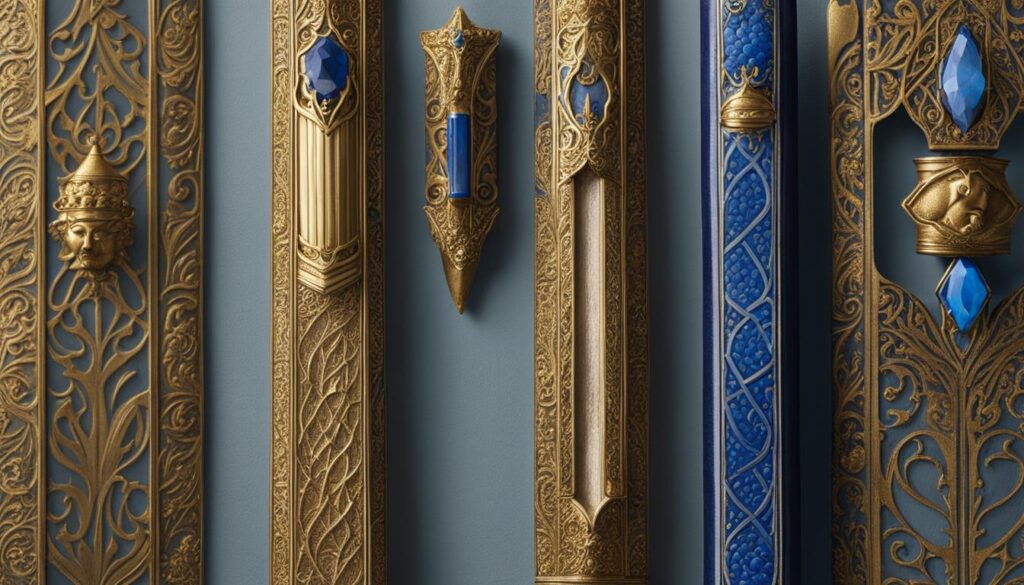
Overall, the name Sha-dai within the mezuzah prayer holds profound meaning for Jewish believers. It serves as a testament to God’s faithfulness, protection, and encompassing presence in their lives. The inclusion of this name on the mezuzah scroll fosters a deep connection with God and reinforces the significance of adhering to His commandments.
The Role of the Mezuzah in Jewish Tradition
The mezuzah has a significant role in Jewish tradition. It is a physical symbol of Jewish identity and a visible expression of faith. The act of affixing a mezuzah to the doorpost is seen as a sacred duty and a way to fulfill the commandments of God. Jewish tradition holds that the presence of a mezuzah in the home brings divine protection and blessings to the inhabitants. It is also customary for Jews to touch or kiss the mezuzah when entering or leaving a room as a sign of reverence and respect for God’s presence.
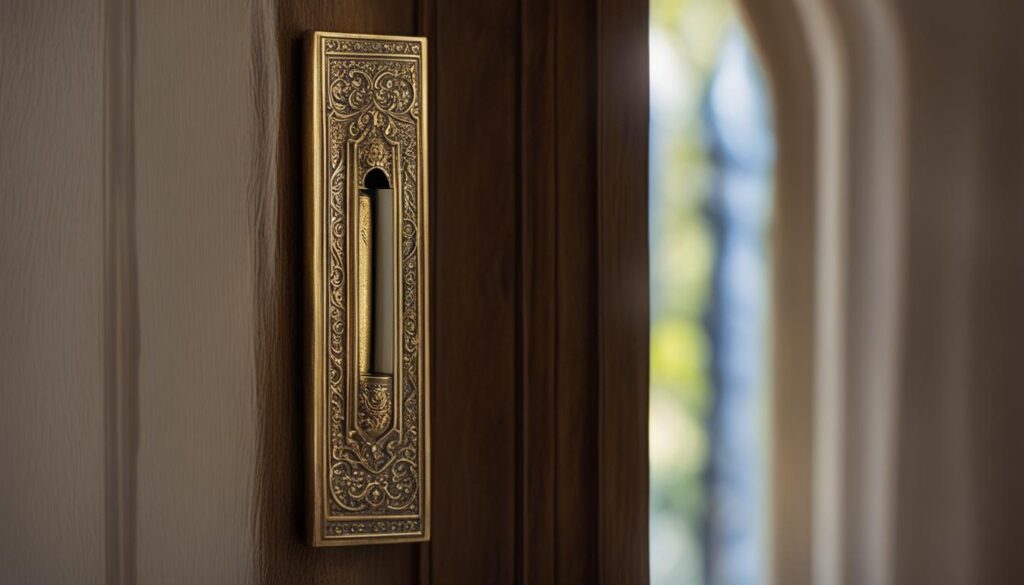
The mezuzah holds deep spiritual and cultural significance in Judaism. It contains the Shema prayer, which serves as a declaration of faith in one God and a reminder of the commandments. The placement of the mezuzah on the doorpost and the recitation of the associated prayers are seen as acts of devotion and a way to bring divine protection and blessings into the home. The mezuzah also represents a connection to the Jewish faith, a symbol of God’s presence, and a source of spiritual grounding and identity.
The Importance of Mezuzah in Jewish Homes
“The mezuzah is an integral part of our Jewish identity. It is not just a decorative item, but a tangible expression of our faith and a constant reminder of our connection to God,” says Rabbi David Cohen.
In addition to its religious significance, the mezuzah serves as a form of spiritual protection and a symbol of God’s presence. It is believed that the mezuzah acts as a shield against evil and brings blessings to the home. The act of affixing the mezuzah to the doorpost is a way for individuals and families to publicly declare their commitment to their faith and their desire to invite God’s presence into their lives.
Throughout history, the mezuzah has played a vital role in Jewish homes, serving as a beacon of hope and a source of comfort during challenging times. It has survived persecution, wars, and displacement, symbolizing the resilience and enduring faith of the Jewish people. Today, the mezuzah continues to hold a special place in Jewish tradition, serving as a reminder of the rich legacy and enduring values that have guided the Jewish community for centuries.
The Future of the Mezuzah and Its Impact on Jewish Beliefs
The practice of placing a mezuzah on the doorpost and reciting the associated prayers holds deep significance in Jewish beliefs. It serves as a tangible connection to the Jewish faith and traditions and a reminder of the commandments of God. As Jewish communities continue to evolve, the mezuzah represents a way to preserve and pass down centuries-old customs and teachings. The mezuzah also plays a role in the ongoing spiritual journey of individuals, providing a source of comfort, protection, and identity as they navigate their relationship with God.
Throughout history, the mezuzah has served as a symbol of Jewish identity, even in the face of adversity and persecution. In times of struggle, the mezuzah becomes a visible declaration of faith, serving as a beacon of hope and resilience. Its presence on the doorpost not only reminds believers of their connection to God but also signals to others that they are entering a Jewish home, fostering a sense of community and shared values.
Moreover, the mezuzah has the potential to influence Jewish beliefs and practices in the future. As technology advances and new forms of communication emerge, the mezuzah may find its place in the digital realm. Virtual mezuzahs could be created, allowing individuals to engage with the sacred prayers and teachings wherever they may be. This digital adaptation could serve as a way to reach a wider audience and ensure the continued relevance of the mezuzah in a changing world.

The mezuzah holds a timeless and enduring role in Jewish beliefs, acting as a physical representation of the divine connection between God and His people. Its future lies in the hands of future generations, who will carry on the sacred tradition and adapt it to the needs of the modern world, while remaining true to the core principles and teachings it represents.
The Mezuzah in the Context of Biblical Prophecy
The mezuzah holds significance not only in Jewish traditions but also in the context of biblical prophecy. It is mentioned in scriptures such as the Book of Numbers and the teachings of Yeshua, the Messiah. These references highlight the importance of the mezuzah prayer and its role in spiritual sifting and preparation for the coming of the Messiah. The mezuzah is seen as a sign of God’s involvement in the lives of His people and a symbol of His ultimate redemptive plan.
In the Book of Numbers, God commands the Israelites to write the words of the Shema on their doorposts as a constant reminder of their faith and commitment to Him. This act of affixing the mezuzah is seen as a way of declaring allegiance to God and His commandments. The mezuzah prayer, inscribed on the scroll within the mezuzah case, serves as a reminder of the Shema, which declares the oneness of God and the importance of loving and serving Him.
In His teachings, Yeshua, the Jewish Messiah, reaffirmed the significance of the mezuzah prayer and its connection to divine blessings and protection. He emphasized the importance of loving God with all one’s heart, soul, and strength, echoing the commandments within the mezuzah prayer.
As believers in Yeshua, many Messianic Jews and Christians alike embrace the mezuzah as a symbol of their faith and a tangible expression of their commitment to God. The mezuzah prayer and its connection to biblical prophecy serve as a reminder of the ongoing spiritual journey and the hope of redemption that is found in relationship with God.
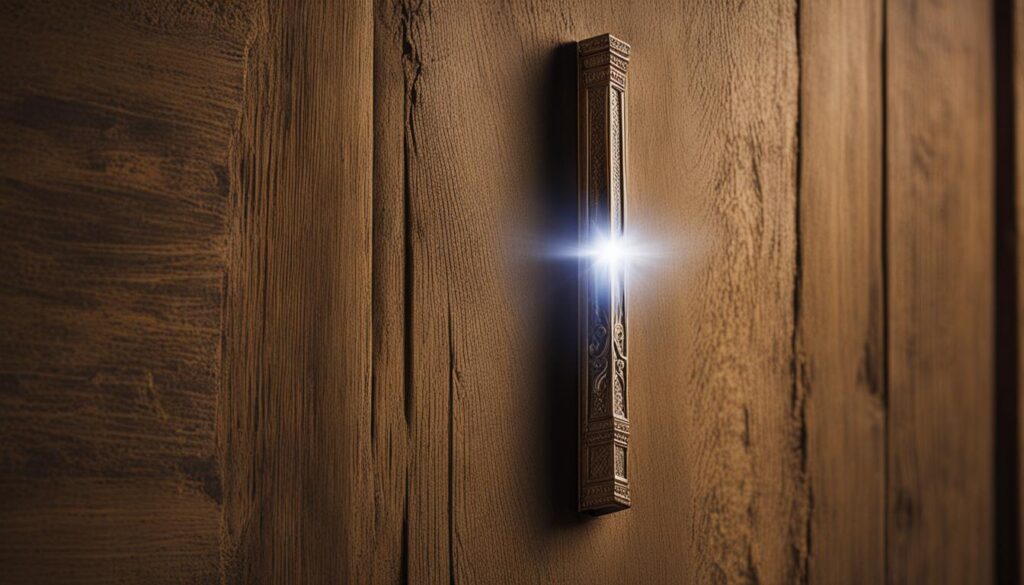
The Mezuzah and the Polarization of Religious and Secular Jews
The placement of mezuzahs on doorposts has contributed to a growing divide between religious and secular Jews in Israel. This polarization is seen as a necessary step in the fulfillment of biblical prophecies and the preparation for the Messiah’s return.
Religious Jews uphold the significance of the mezuzah prayer and see it as a way to protect and preserve their faith. The mezuzah represents a tangible connection to God and a source of spiritual grounding. For them, the mezuzah serves as a reminder of their commitment to follow God’s teachings and invite His blessings into their lives.
On the other hand, secular Jews may view the mezuzah as a symbol of religious traditions they have chosen to distance themselves from. They may see it as a reminder of a more conservative and traditional version of Judaism that does not align with their own beliefs and practices. This divide reflects the ongoing spiritual sifting and the fulfillment of biblical prophecies.
| Religious Jews | Secular Jews |
|---|---|
| Uphold the significance of the mezuzah prayer | View the mezuzah as a symbol of religious traditions they have chosen to distance themselves from |
| See the mezuzah as a way to protect and preserve their faith | Perceive the mezuzah as a reminder of a more conservative and traditional version of Judaism |
| View the mezuzah as a tangible connection to God and a source of spiritual grounding | Do not align with the beliefs and practices associated with the mezuzah |
This polarization showcases the ongoing spiritual journey of the Jewish people and the fulfillment of biblical prophecies. It highlights the complexity of religious identity and the diverse ways individuals engage with their faith. The mezuzah serves as a symbol of devotion and a reflection of personal beliefs, regardless of how it is interpreted or practiced.
Conclusion
The mezuzah holds deep spiritual and cultural significance in Judaism. It contains the Shema prayer, which serves as a declaration of faith in one God and a reminder of the commandments. The placement of the mezuzah on the doorpost and the recitation of the associated prayers are seen as acts of devotion and a way to bring divine protection and blessings into the home.
The polarization between religious and secular Jews in relation to the mezuzah reflects the ongoing spiritual journey of the Jewish people and the fulfillment of biblical prophecies. It underscores the importance of the mezuzah as a symbol of faith and identity. While religious Jews embrace the mezuzah as a sacred reminder of their traditions, some secular Jews may view it differently, emphasizing the need for understanding and respect.
Ultimately, the mezuzah represents a connection to the Jewish faith, a symbol of God’s presence, and a source of spiritual grounding and identity. Its significance extends beyond religious rituals and permeates the cultural fabric of the Jewish community. The mezuzah serves as a tangible expression of devotion and a constant reminder of the spiritual values that guide the lives of believers.
FAQ
What prayer is in the mezuzah?
The prayer inside the mezuzah is known as the Shema, which is a declaration of faith in one God. It includes the first two verses of the Shema prayer, beginning with “Hear, O Israel, the Lord is our God, the Lord is One.”
What is the importance of the mezuzah scroll?
The mezuzah scroll contains the handwritten prayers of the Shema, serving as a reminder of the Jewish faith and the commandment to love and serve God. It is a sacred symbol of God’s presence in the Jewish home and a source of spiritual protection and blessing.
What does the mezuzah case represent?
The mezuzah case is a decorative container that holds the mezuzah scroll. It serves as a practical and symbolic representation of the mezuzah on the doorpost, protecting the scroll and reflecting personal or cultural preferences.
Where should a mezuzah scroll be hung?
The mezuzah scroll should be hung on the right side of the doorpost, at a slanting position with the top facing inward. It should be placed within the top third of the doorway, ensuring visibility to anyone entering or exiting the house.
What is the connection between the Aaronic Blessing and the mezuzah prayer?
The mezuzah prayer draws parallels between the hand gestures used by priests during the Aaronic Blessing and the placement of hands on the mezuzah scroll. This connection highlights the spiritual significance of the mezuzah prayer and its connection to divine blessings and protection.
What is the spiritual symbolism of the mezuzah?
The mezuzah serves as a constant reminder of the Jewish faith and the commandments of God. It represents a desire for a God-centered life and a commitment to follow His teachings. The mezuzah is a symbol of God’s presence, spiritual protection, and blessing.
What is the significance of the name Sha-dai in the mezuzah prayer?
The name Sha-dai, one of the names of God, is inscribed on the mezuzah scroll. It signifies God as the Guardian of the doorways of Israel, offering divine protection and care to those who trust in Him. The presence of this name represents God’s faithfulness and His involvement in the lives of His people.
What is the role of the mezuzah in Jewish tradition?
The mezuzah is a physical symbol of Jewish identity and a visible expression of faith. Its presence in the home brings divine protection and blessings to the inhabitants. The act of touching or kissing the mezuzah is a sign of reverence and respect for God’s presence.
What is the future of the mezuzah and its impact on Jewish beliefs?
The mezuzah continues to be a significant part of Jewish tradition, preserving and passing down centuries-old customs and teachings. It plays a role in the ongoing spiritual journey of individuals, providing comfort, protection, and identity in their relationship with God.
How does the mezuzah relate to biblical prophecy?
The mezuzah is mentioned in scriptures such as the Book of Numbers and is seen as part of the preparation for the coming of the Messiah. Its inclusion in biblical prophecies reflects the importance of the mezuzah prayer and its connection to God’s redemptive plan.
How does the mezuzah contribute to the polarization of religious and secular Jews?
The placement of mezuzahs on doorposts has created a divide between religious and secular Jews. While religious Jews uphold the significance of the mezuzah prayer, secular Jews may view it as a reminder of traditions they have distanced themselves from. This reflects the ongoing spiritual journey and fulfillment of biblical prophecies.
What is the conclusion regarding the mezuzah prayer?
The mezuzah prayer inside the mezuzah scroll holds deep spiritual and cultural significance in Judaism. It serves as a declaration of faith and a reminder of God’s commandments. The mezuzah represents a connection to the Jewish faith, a symbol of God’s presence, and a source of spiritual grounding and identity.


